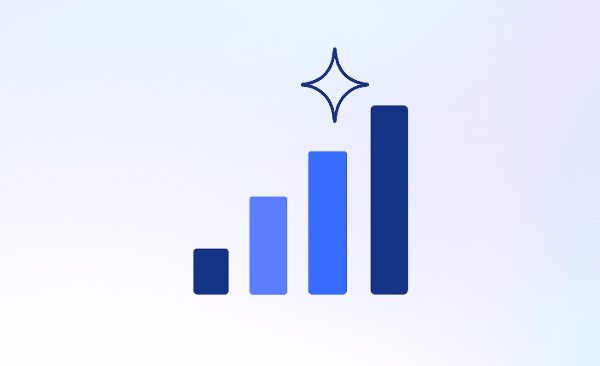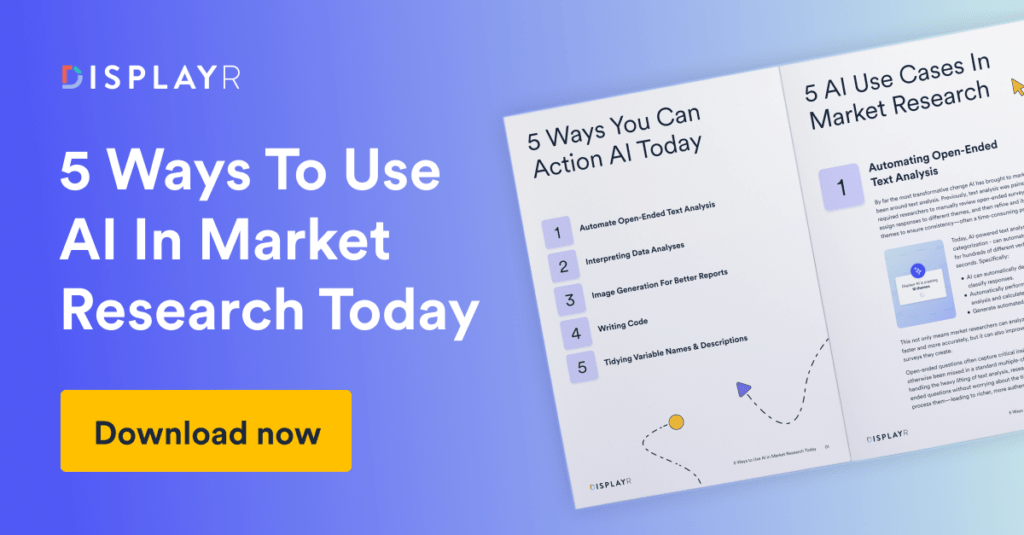Data analysis is hard - so why not bring in some extra help? Thanks to agentic AI, today’s researchers and analysts can build personalized data analysis agents to take on the heavy lifting and turn data into insights in seconds.
These AI agents are not only available, they are accessible. A growing number of software platforms now offer data analysis agents straight out of the box. In many cases, it’s as simple as connecting your dataset and unleashing your very own AI-powered analyst.
But to fully reap the benefits of agentic AI in data analytics, it's worth understanding how these AI data analysis agents are created and how you can tailor (or even build) your own to fit a specific workflow.
What is a Data Analysis AI Agent?
A data analysis agent is an AI-powered tool designed to automate and streamline analytical workflows for researchers and analysts. It can handle tasks such as cleaning and structuring data, running statistical analyses, generating visualizations, and even drafting reports - freeing up time for deeper interpretation and strategic thinking.
These agents can be tailored to specific use cases, such as survey reporting or sales forecasting, and often integrate with existing data sources and tools to deliver end-to-end automation. By combining speed, scalability, and intelligence, data analysis agents enable teams to produce faster and more consistent insights with less manual effort.
1. Define the Use Case of Your Data Analysis Agent
OpenAI defines agents as systems that intelligently complete tasks, from simple workflows to open-ended objectives. This means that in order for your AI agent to be successful, you must first define the business problem you want it to solve. In terms of data analysis, this might be survey reporting or sales trend detection.
Once you have identified what you want your AI agent to solve, you can move to defining how it will achieve this. Specify the exact outputs you want the agent to produce (summaries of data, visualizations, intelligent recommendations, etc.) so you can start creating the appropriate workflow. You should also identify the data sources your agent will draw from (e.g., CSVs, Excel, database connections, APIs).
Another important initial step is to decide if the agent is to be fully autonomous or if it supports human collaboration. This choice determines how much control you retain and how much decision-making power is delegated to the agent.
2. Design the Data Agent’s Workflow
After defining the use case, the next step is mapping out the exact steps the AI should take. This typically will involve some user research. For example, if you were to ask users how they currently analyze their survey data, most respondents would describe the manual steps of importing data, running crosstabs, filtering responses, creating charts, and then writing summaries. By establishing the exact steps required to take users towards their end goal, you can map out the agent's AI-driven workflow.
Another approach is to take a modular approach, i.e., creating numerous agents to perform smaller tasks. These smaller outputs can then be orchestrated by an overarching 'conductor' agent that coordinates the interactions. In terms of data analysis, this might look like the development of a data cleaning agent, a variable selection agent, and a visualization agent - which would all then fall under a general data analysis agent.
This approach enhances the overall reliability of the workflow, facilitates more sophisticated problem-solving, and facilitates easier debugging. That's why this approach has been a hugely popular approach so far in the development of agentic AI.
3. Engineer the Prompts and Interactions
Prompts represent the fundamental communication link between humans and AI agents, guiding how the agent behaves and what outputs it generates. In many cases, prompts function like a lightweight programming language for large language models (LLMs), defining tasks, tone, structure, and logic. If you were to ‘look under the hood’ of many AI agents today, you'd find that their agentic capabilities are often powered by a sequence of structured prompts, executed step-by-step to simulate reasoning and task completion.
This is why developing effective prompts is so important, as the specificity of the prompt determines the accuracy of the output. As mentioned above, AI agents rely on natural language prompts to interpret tasks, rather than the more traditional use of code in software development to specify exact procedures. For example
- Asking the AI to "analyze this data" would result in a poor output
- Asking the AI to "summarize the key trends in this sales table, highlighting any month-over-month changes greater than 10% and identifying the top three performing product categories" would be much more effective.
The most effective prompts are structured with programmatic logic rather than relying solely on conversational language; while they may appear to be written in plain English, the closer they resemble the logical flow and specificity of a computer program, the more reliable and predictable the results will be.
4. Integrate the AI Model(s) with the Data Agent
Once the workflows have been determined and the prompts are in place, it comes time to bring the AI agent to life by connecting it to AI models. Choosing the right assortment of models requires a deep understanding of your use case, as well as knowledge of what's available. LLMs are how you interpret and generate text. Code generation models can be used for technical tasks, while vision models will allow you to create any images or charts.
Your integration should support a variety of input and output formats - everything from structured data to rich text, charts, and HTML. This makes it easier for users to interact with and edit the agent’s output.
On the technical side, it's important to build a reliable infrastructure. Secure your API connections, use authentication, and set up systems to handle errors or delays if the AI service is unavailable. Validate outputs before they’re shown to users to maintain quality.
5. Build User Interaction & Review Loop
One of the key benefits of an AI agent is that it can continually improve as it gains more experience. The key here is to ensure the AI agent is collaborative, rather than a black box. Users should be able to answer clarifying questions, upload contextual documents, and confirm choices as the agent progresses through its workflow, ensuring that the analysis remains aligned with their specific needs and objectives.
This review loop is why it is also crucial that the agent presents a clear summary of what was done and why, providing users with an audit trail. This will not only help your end users establish confidence in the results but also help them understand the analytical reasoning behind each output. This transparency also serves a practical purpose, as it allows users to learn from the agent's approach and apply similar methodologies to future analyses.
The review loop should be designed to feel natural and conversational, allowing users to iterate on results through dialogue rather than navigating complex menus or restarting entire processes.
6. Enable Automation & Orchestration
As mentioned above, the modular, multi-agent approach is an effective way to facilitate complex workflows. This requires the implementation of multi-agent orchestration, where specialized agents handle specific tasks and results are combined hierarchically.
In the case of data analysis, a data cleaning agent processes raw input, passing the results to a variable selection agent, which then feeds them into a visualization agent.
All these components are coordinated by a master orchestrator agent that manages the overall workflow and ensures quality at each step. Remember, the goal when orchestrating multi-step workflows should be to mirror how experienced data analysts break down complex projects into manageable single components.
Your system should support real-time data updates, allowing outputs to automatically refresh as underlying data changes. This maintains accuracy without requiring users to manually regenerate reports each time new information becomes available. This is particularly valuable for ongoing tracking studies, dashboards, or any analysis that requires staying current with evolving data sources.
7. Address Security, Privacy, and Controls
Security, privacy, and access controls must be built into your AI agent from the outset (rather than as an afterthought). That means thinking beyond just functionality and ensuring your agent handles sensitive data responsibly, stays compliant, and gives users appropriate levels of access. Some best practices to follow to ensure your agent is secure include;
- Set role-based permissions: I.e., define who can use the agent and what they can see or edit.
- Integrate with existing security systems: Use your organization’s identity management and access control tools to manage and audit usage.
- Use privacy-preserving techniques: Apply data anonymization or differential privacy if handling personal or sensitive information.
- Track and log everything: Build audit logs to monitor access and ensure transparency and compliance.
- Enable consent management: Let users control how their data is used and give them clear options to opt in or out.
8. Deploy, Monitor, and Iterate
To ensure the data analysis AI agent has long-term success, it's important to pay close attention to how you deploy the tool, then monitor ongoing use.
In terms of deployment, the agent should ideally be placed into the existing reporting and analysis environment. This will make the agent feel like an extension of the existing capabilities for users, rather than a separate system that requires additional learning.
Once deployed, monitoring usage becomes essential. Closely look at the frequency of use, popularity of specific features, and any sticky points that are causing friction. Capture user feedback, log errors systematically, and track metrics that demonstrate how the agent is saving users' time with their data analysis.
It's also crucial that you put systems in place to help with verifying AI outputs, as AI agents carry the potential risk of hallucinations and errors. If you are rolling out an agent for thousands of customers, it is impossible to verify every single output. Instead, you should establish verification checkpoints and assist your users in identifying potential issues and remaining vigilant.
Ready to see how Displayr's Research Agent can revolutionize your survey analysis? Start a free trial today.




